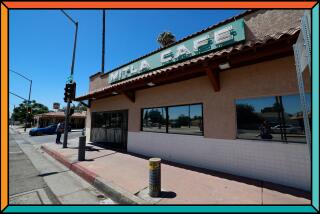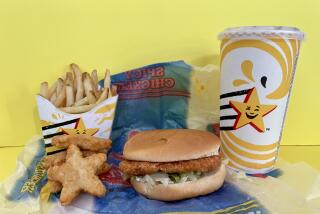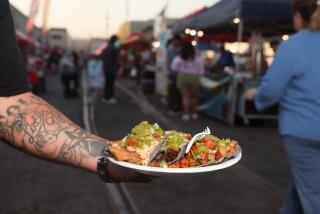Taco Bell Trims Fat to Boost Sales--Will It Work? : Fast food: The company may need more than its new Border Lights menu to regain its competitive edge, analysts say.
- Share via
IRVINE — With its breakthrough “value pricing” strategy already pushed to its limits, Taco Bell Corp. on Wednesday bid to reverse a sales slowdown by unveiling a new menu of lower-fat, reduced-calorie fast food.
At a presentation in New York, Taco Bell executives introduced Border Lights, a line of products with about half the fat of the restaurant chain’s standard fare and about 20% fewer calories.
But analysts said Taco Bell, which cut 75 jobs Tuesday at its corporate headquarters here, may need more than a new menu to regain its edge in the highly competitive fast-food industry.
Nutrition is of little concern to the young consumers who are the target market of fast-food restaurants, said Terry Bivens, an analyst at Argus Research in New York. “I don’t think most 18-year-old kids care,” he said. “To them, it’s still about price and flavor.”
If Bivens is right, Taco Bell’s new tactic could backfire. The lower-fat menu items will cost more than the company’s conventional products--about 10 cents more per item, on average--and that could put Taco Bell at a cost disadvantage.
PepsiCo Inc., Taco Bell’s parent company, “likes to compete on price and volume across a wide range of products, but they’ve gotten price down to the point where it’s difficult to do more,” Bivens said. The concept of value pricing, which Taco Bell pioneered in the 1980s, “has run out of gas,” he added.
Pepsico reported Tuesday that sales at Taco Bell stores open more than a year were down 2% for the fourth quarter, though total operating profit and revenue were higher.
A healthier menu might increase the frequency of some customers’ visits to fast-food restaurants, said Ron Paul, a restaurant industry consultant in Chicago. But convenience still ranks as the most important factor in a fast-food chain’s appeal, he said--followed closely by price.
“There are enough alternatives,” Paul said, “that a chain can’t forget its focus, what it’s competing on.”
Pressures on fast-food chains to provide lower-fat products increased last year when the Center for Science in the Public Interest issued a report criticizing Mexican restaurants for serving cheese-laden dishes and fried foods with fat content far beyond levels considered healthy by nutritional experts.
Although the center examined mid-priced Mexican food chains such as Chi-Chi’s and El Torito, as well as independent restaurants, analysts said the report hurt fast-food sales as well.
Paul Hitzelberger, executive vice president for marketing at Del Taco Inc. in Orange, said his rival’s new lower-fat products may appeal to people who eat fast food only occasionally. Even so, he said, added sales from that group might not cover the cost of the Border Lights ad campaign, which premiered to mixed reviews during the Super Bowl telecast last month.
Del Taco offered a line of healthier items in 1990, including whole wheat tortillas and fish tacos, but Hitzelberger said the menu met with little success and was dropped.
At El Pollo Loco Inc., also a major player in the Mexican-style fast-food market, executives said it remains to be seen whether Taco Bell’s new menu will appeal to health-conscious diners.
“I think a lot of people might go out and try it, but it’s going to come down to taste--whether people can tell the difference,” said Ray Perry, president of the Irvine-based subsidiary of Flagstar Cos.
This week’s layoffs at Taco Bell, which cut about 10% of the corporate staff, hit at all levels, including departments charged with developing future business opportunities, Chairman John Martin said.
“We decided to eliminate some of the projects we were working on that weren’t as high-impact as others,” he said.
The cuts came a little more than seven months after state and local officials offered tax credits and other incentives to keep Taco Bell from moving its headquarters out of California. Another factor in the company’s decision to stay was that it negotiated more favorable terms on the lease for its Irvine office tower.
Martin attributed the decline in same-store sales to 1994 being “a real tough year for us,” especially after the release of the report by the Center for Science in the Public Interest.
Taco Bell reported operating profit of $270.3 million for 1994, up 7% from $253.1 million in 1993. Annual sales rose 17%, to $3.4 billion from $2.9 billion.
Martin tied the slow income growth to the company’s decision to increase to 25,000 from 9,000 the number of restaurants, stores and kiosks that offer Taco Bell products. While that expansion was expensive, Martin said, “in the long term, it’s positive for our business.”
The Border Lights ad campaign itself is under fire from Latino groups, which are protesting that it brings to mind tensions at the U.S.-Mexico border, where federal agents have strung high-powered lights to help them spot people trying to enter the United States illegally.
Taco Bell’s Super Bowl commercials showed people staring at bright lights in the night sky.
Spokesman Jonathan Blum dismissed comparisons of the commercial to any actual situation. “Our ‘Cross the Border’ theme is a state of mind, not a geographical location,” he said.
More to Read
Inside the business of entertainment
The Wide Shot brings you news, analysis and insights on everything from streaming wars to production — and what it all means for the future.
You may occasionally receive promotional content from the Los Angeles Times.










